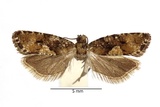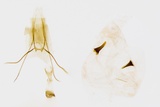Zeiraphera ratzeburgiana (Saxesen, 1840) Species
Last modified: Nov. 24, 2025, 7:32 p.m.
A very rare and scattered species in Belgium. Not often observed but often confused with the very variable Zeiraphera isertana.
Details
- Classification
- Family: Tortricidae > Subfamily: Olethreutinae > Tribus: Eucosmini > Genus: Zeiraphera > Species: Zeiraphera ratzeburgiana
- Vernacular names
- Naaldboombladroller (NL), Spruce-bud Moth (EN)
- First mention in Belgium
- Janmoulle E. 1962a. Espèces nouvelles pour la faune belge (suite). — Lambillionea 62(3–6): 39–40, 41. On page 39.
- Status
-
Native
Distribution
Caterpillar
The caterpillar is transparent white to yellow-green. The head is reddish brown, the prothoracic plate is light reddish brown. The prolegs are black. The pinacula are strikingly large and dark brown.
Bionomics
The young larva penetrates the top of a bud that is just opening and eats the developing needles. While still young, it can make spot mines in the top of a needle. During most of its life it is protected by the bud scales that do not fall off because they are secured with silk.
The adults become active near sunset and later come to light.
Flight periods
The adults fly from late June towards mid-August.
Observed on
- Host plant (species):
- Picea abies, Picea sitchensis, Picea smithiana, Abies alba, Abies cephalonica, Abies grandis, Pinus sylvestris and Pinus pinea
The larva lives on different species of conifers like Picea, Abies and Pinus. The main food plant is Picea abies.
Habitat
It inhabits spruce and pine forests, plantations, parks and gardens and similar situations where there are ornamental conifers.



